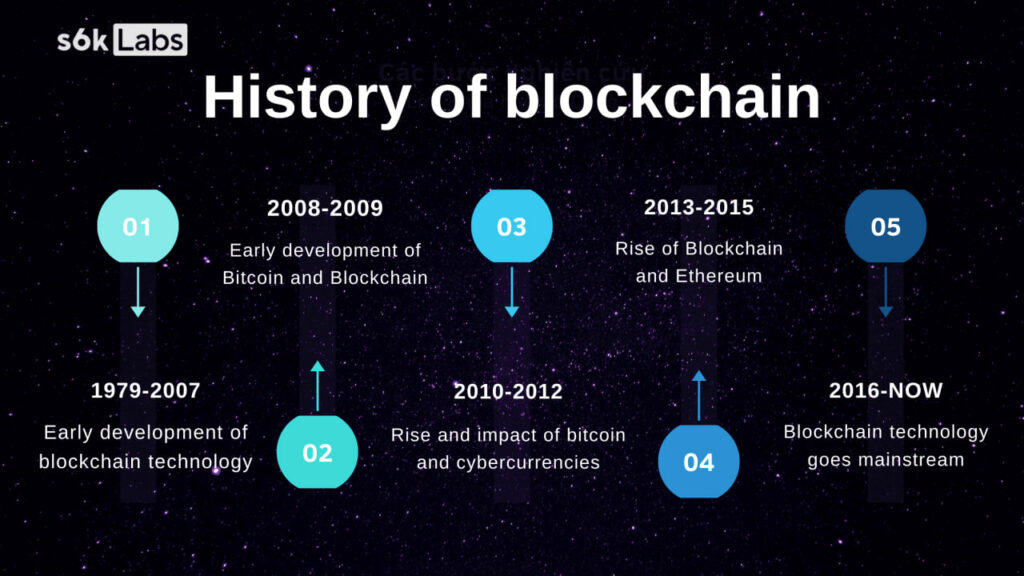The history of blockchain dates back to the late 1970s when computer scientists first began exploring the concept of a digital ledger system that could be used to record and verify transactions. Over the decades that followed, blockchain technology went through various stages of development and refinement, eventually leading to the creation of the first blockchain-based digital currency, Bitcoin, in 2009.
In this article, s6kLabs will explore the history of blockchain in detail, from its early origins to its present-day impact and future potential.

1979-2007: The early development of blockchain technology
The early development period, spanning from 1979 to 2007, played a significant role in shaping the history of blockchain technology.
The concept of a digital ledger system was first proposed in 1979 by computer scientist Ralph Merkle, who suggested using cryptographic techniques to create a secure database of transaction records. Over the next few decades, several other researchers and developers contributed to the development of digital ledger systems, including David Chaum, who developed the first digital currency, DigiCash, in the 1990s.
One of the most significant contributions to the development of blockchain technology came in 2004 when a developer named Hal Finney created a system called Reusable Proof of Work (RPOW), which used a decentralized network to verify and record transactions. While RPOW was not a true blockchain, it laid the groundwork for the development of future blockchain-based systems.
2008-2009: The early development of bitcoin and blockchain
In 2008, an anonymous developer or group of developers using the pseudonym Satoshi Nakamoto released a white paper outlining a new digital currency called Bitcoin. The paper described a decentralized system that used cryptographic techniques to verify and record transactions on a public ledger, which would later become known as the blockchain.
The first Bitcoin transaction occurred in January 2009, and by the end of that year, the cryptocurrency had gained a small but dedicated following. Many in the mainstream financial industry initially viewed Bitcoin with skepticism, but it quickly gained traction as a viable alternative to traditional currency.
2010-2012: The rise and impact of bitcoin and cybercurrencies
In the early 2010s, Bitcoin began to gain wider acceptance and recognition as a legitimate form of currency. More and more merchants began accepting Bitcoin payments, and the cryptocurrency’s value soared, reaching a high of almost $20,000 in 2017.
The rise of Bitcoin also paved the way for the development of other digital currencies, known as altcoins or cybercurrencies. In 2011, the creation of Litecoin and the development of Ripple in 2012 were notable events in the expansion of digital currencies.
While cybercurrencies faced significant regulatory and legal hurdles, they also offered a number of advantages over traditional currency, including faster transaction times, lower fees, and increased security, which helped to shape the further development of the origin of blockchain technology.
2013-2015: The rise of Blockchain and Ethereum
In 2013, a developer named Vitalik Buterin proposed the creation of a new blockchain-based platform called Ethereum, which would allow developers to build decentralized applications (dApps) on top of the blockchain. Ethereum launched in 2015, demonstrating that blockchain technology has potential beyond currency transactions and marking a significant milestone in its development.
Ethereum’s smart contract technology allowed for the creation of a wide range of applications, from decentralized marketplaces to voting systems to online gaming platforms. The platform’s flexibility made it a popular choice among developers and entrepreneurs, and it helped to further cement blockchain’s position as a transformative technology.
2016-present: Blockchain technology goes mainstream
Over the past few years, blockchain technology has continued to gain momentum and has begun to see widespread adoption in a variety of industries. Major corporations, including IBM, Microsoft, and JP Morgan, have invested heavily in blockchain research and development, while startups and entrepreneurs have created a range of new blockchain-based products and services.
The future of blockchain technology
As we move into the future, it’s clear that blockchain technology will continue to play an important role in many different industries. From finance and banking to healthcare and logistics, blockchain has the potential to revolutionize the way we do business and interact with one another.

Blockchain technology is expected to have a major impact in the field of supply chain management. By using blockchain to track goods and products as they move through the supply chain, businesses can increase transparency and accountability while reducing the risk of fraud and counterfeiting.
Blockchain technology is expected to make a big impact in the realm of identity management, as it has the potential to improve security and efficiency in the process. By using blockchain-based solutions, individuals can take control of their own personal data and share it with others in a secure and decentralized way.
As the technology continues to evolve, we can also expect to see new and innovative use cases emerge. Blockchain-based systems could facilitate secure online voting or create more transparent and democratic systems of governance.
FAQs
When was blockchain first created?
The concept of blockchain was first introduced in 1991 by Stuart Haber and W. Scott Stornetta. However, the first functional blockchain was created in 2009 with the launch of Bitcoin.
Who invented the first blockchain?
Stuart Haber and W. Scott Stornetta developed the concept of blockchain, but an individual or group operating under the pseudonym Satoshi Nakamoto created the first functional blockchain.
What was the 1st blockchain?
In 2009, the launch of Bitcoin resulted in the creation of the first functional blockchain, which recorded and verified transactions on the Bitcoin network. Since then, it has become the most widely used blockchain in the world.
In conclusion, the history of blockchain technology is a fascinating and complex journey that has taken us from the early development of cryptographic systems in the 1970s to the widespread adoption of blockchain-based solutions in the present day.
If you are looking for technology solutions, including blockchain development, contact us today to learn more about our services and how we can help you implement cutting-edge solutions for your business. With our expertise and experience, we can help you stay ahead of the curve and achieve your goals in a rapidly evolving technological landscape.

